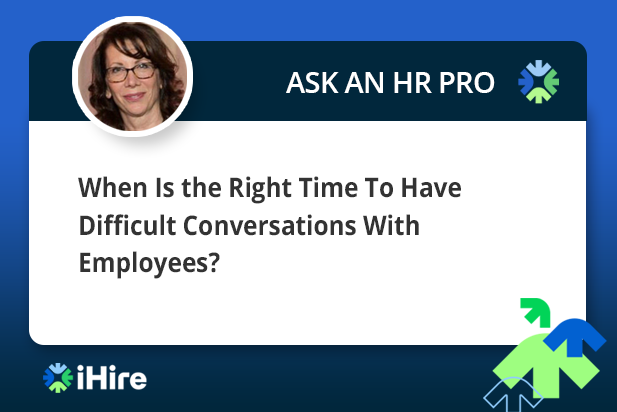- Employer Resources
- |
- Last Updated: August 16, 2022

Ask an HR Pro: When Is the Right Time To Have Difficult Conversations With Employees?
Whether it’s for an employee’s poor performance or bad behavior, or if you’re giving unfortunate news, you will likely need to have a few tough conversations throughout your career. Avoiding these difficult conversations with employees instead of addressing the issue can make things worse, but how do you know when the right time to have “the talk” is?
In this month’s Ask an HR Pro, we asked Chrisanne Bowden, iHire Senior HR Consultant, when you should have these difficult meetings and other tips for difficult conversations.

When to Have Difficult Work Conversations
So, when should you be having tough conversations? Is it after the first sign of trouble, or should the employee have some leeway first?
“The talk is typically never going to happen after their first mistake,” Bowden said. “If you have a new hire – and even they do something fairly noticeable – I don’t think you want to set the tone that you’ll immediately reprimand them for any small mistake. However, if it’s something more severe, like they’ve just come in and their behavior is not in line with the professionalism and culture of the office, then I would say, ‘Hey let’s talk about this, your behavior and actions are not conducive to who we are as an organization.’”
Your first instinct may be to correct the mistake, but it’s important to understand the right way to do so. If it’s the employee’s first time making that error, it’s likely that they didn’t know the proper procedure or expected behavior. So instead of a formal talking-to, they may just need additional coaching.
“With a new employee or someone promoted into a new role, you should expect a learning curve and be willing to spend time with them to help them get adjusted,” Bowden continued. “Before a meeting happens, just make sure there’s been an appropriate amount of coaching for the employee so that if they’re still falling short, it’s appropriate to have a sit-down talk.”
If they’ve had adequate coaching and are still making mistakes, then you can have the needed discussion.
Create an Account for More HR Tips
Tips for Difficult Conversations at Work
Once you’ve determined a formal meeting is required, Bowden provided some tips that you can follow to ensure everything goes smoothly.
“The first step is to reframe the conversations in your mind,” she advised. “If you consider them challenging, then they will be. Difficult conversations can be handled successfully by thinking of them as ‘necessary’ or ‘important’ instead. This will allow you to focus on the outcome, not the talk itself.”
Bowden also recommends setting a tone of open and honest communication. Usually, the goal is to come to an understanding of the underlying issue and determine the next steps to fix it. If you have a transparent conversation and try to understand the employee’s point of view, a positive outcome is much more likely.
Other tips for handling difficult conversations successfully include:
- Prepare beforehand by gathering the facts before the meeting.
- Have the conversation face-to-face (in person or over video), privately, and establish a safe space so that everyone knows they can speak truthfully.
- Consider the employee’s side of the story.
- Don’t focus entirely on the negative. If an employee has been doing well in other areas, you can mention that too.
- Remain calm. If you find yourself getting worked up, take a breath or pause the conversation.
- Invite a third party if necessary.
- Work with the employee to find a solution and set up a plan to reach it.
- Follow up with the employee after a predetermined amount of time and evaluate their progress.
Remember, difficult conversations can be handled successfully if you give the employee enough time to learn and hold open, honest discussions to correct repeated poor performance. For more answers to your HR questions, check out our Employer Resource Center.

Originally Published: July 27, 2022




